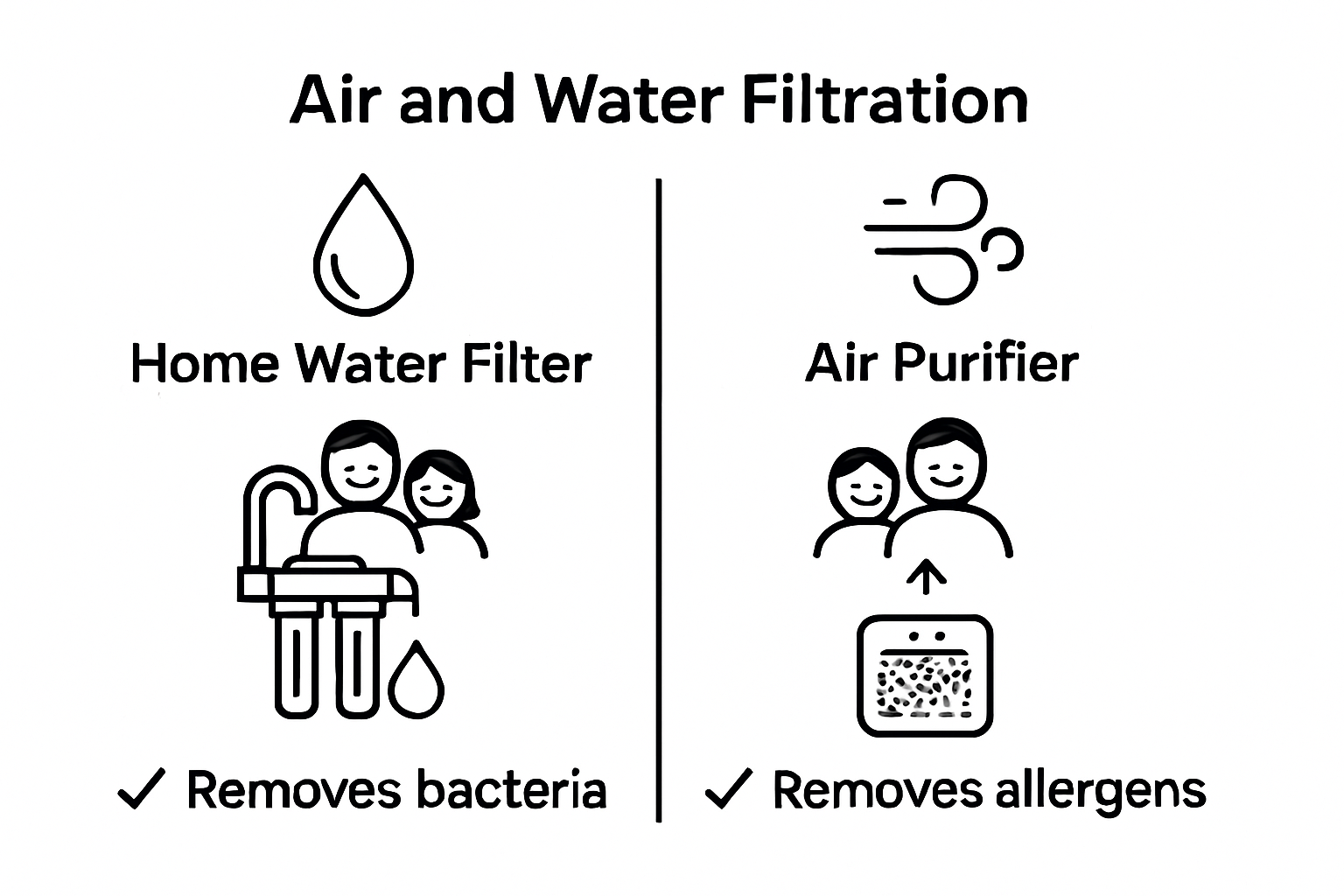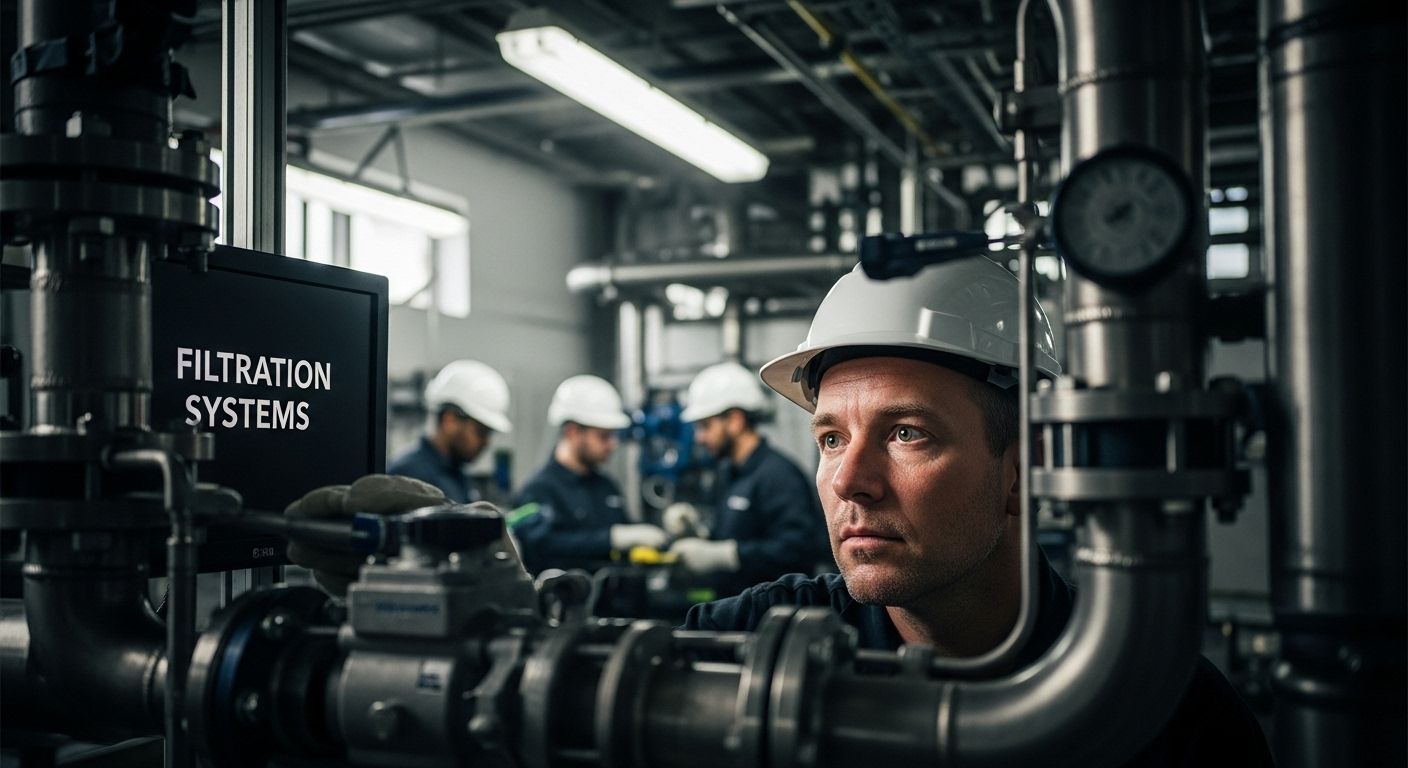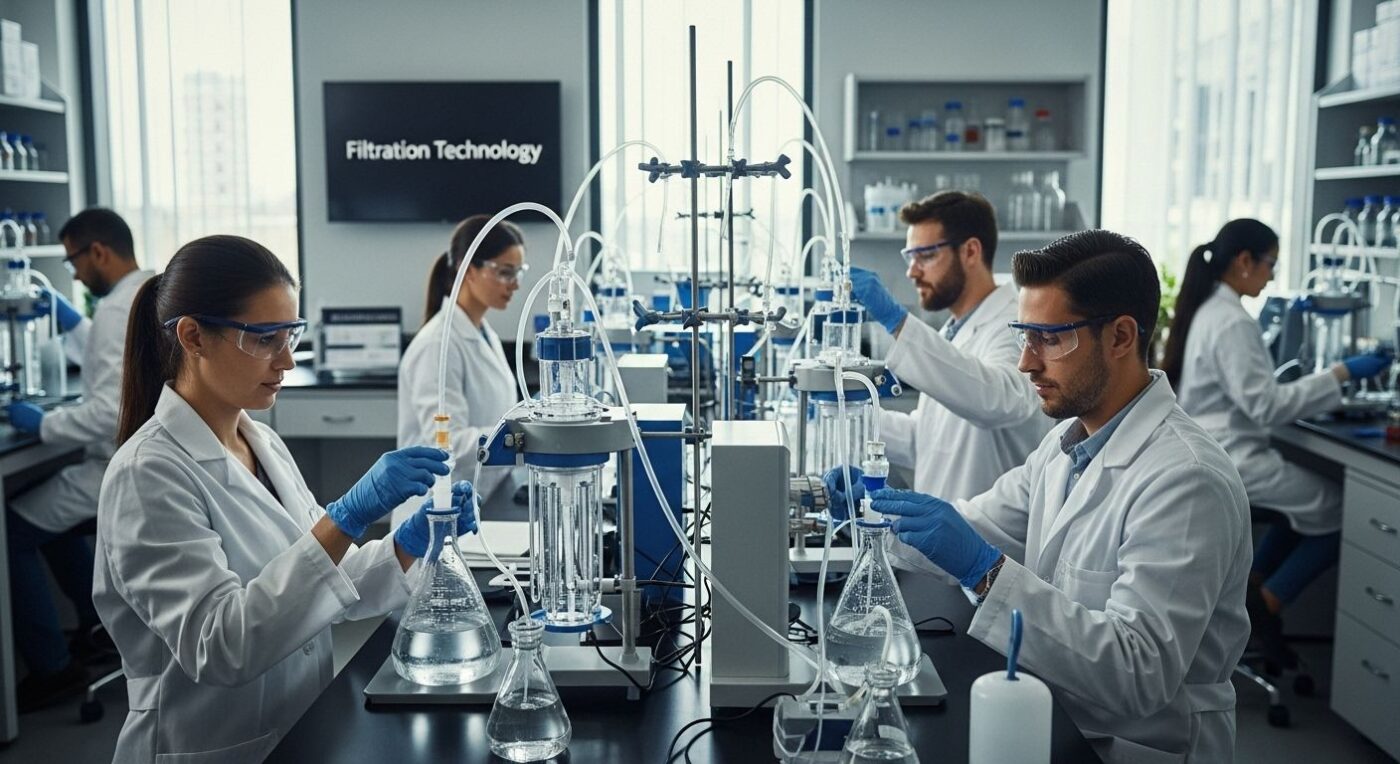Uncategorized
Understanding the Role of Filtration Technology
Filtration technology is reshaping how we keep our air, water, and everyday products clean and safe. You might think filters just trap dirt and dust, but that barely scratches the surface. Some advanced systems can separate substances down to the molecular level, offering protection against invisible threats you never even knew existed. The real surprise is how this scientific process guards your health in ways far beyond what most people realize.
Table of Contents
- What Is Filtration Technology?
- Why Filtration Technology Matters For Health
- How Filtration Technology Works: Basic Principles
- Key Types Of Filtration Systems And Their Uses
- Real-World Applications Of Filtration Technology
Quick Summary
| Takeaway | Explanation |
|---|---|
| Filtration removes harmful contaminants. | Effective filtration technology safeguards health by eliminating pollutants in air, water, and food systems. |
| Various filtration mechanisms exist. | Filtration employs techniques like straining, sedimentation, and interception to separate undesirable particles efficiently. |
| Advanced systems target microscopic threats. | High precision filtration systems can remove even the smallest contaminants, preventing health issues. |
| Key applications span multiple sectors. | Filtration technology is crucial for healthcare, industrial processes, and environmental protection, ensuring safety and efficacy. |
| Maintenance is critical for optimal performance. | Regular maintenance of filtration systems is necessary to consistently achieve effective health protection and purification. |
What is Filtration Technology?
Filtration technology represents a sophisticated process of separating particles, contaminants, and unwanted substances from liquids or gases through specialized mechanisms. This advanced method leverages scientific principles to remove impurities, ensuring cleaner and safer environments across numerous applications.
Core Principles of Filtration
At its fundamental level, filtration technology operates through selective separation. It uses physical barriers, chemical interactions, and precise engineering to extract specific particles based on size, molecular structure, and other characteristics. The process involves pushing a substance through a medium that captures undesired elements while allowing pure components to pass through.
According to the U.S. Environmental Protection Agency, filtration technology plays a critical role in improving environmental quality by removing pollutants and contaminants from air and water systems. This technology has wide-ranging applications across multiple sectors, including:
- Healthcare and medical equipment
- Industrial manufacturing
- Water treatment facilities
- Air purification systems
- Food and beverage production
Mechanisms of Filtration
Filtration technologies employ various mechanisms to achieve particle separation. These include mechanical filtration (physical blocking), depth filtration (trapping particles within a porous material), surface filtration (capturing particles on a membrane surface), and advanced techniques like electrostatic precipitation and membrane filtration.
The complexity of filtration technology means different systems are designed for specific purposes. Some focus on removing microscopic contaminants, while others target larger particulate matter. The intricate engineering behind these systems ensures precise, efficient separation that meets stringent quality standards.
By understanding filtration technology, we gain insight into how critical environmental and health protection mechanisms work, transforming raw substances into purified, safe resources for human consumption and industrial use. Read more about water filtration principles to explore these fascinating scientific processes in greater depth.
Why Filtration Technology Matters for Health
Filtration technology has become an essential component in protecting human health by removing potentially harmful contaminants from our immediate environment. As our world becomes increasingly complex with multiple sources of pollution, understanding how filtration technology safeguards our well-being has never been more critical.
Protecting Against Environmental Contaminants
Modern living exposes humans to numerous invisible health threats through air, water, and food systems. Filtration technology serves as a critical barrier against these potential hazards. According to the U.S. Environmental Protection Agency, effective filtration can remove dangerous particulates that contribute to respiratory and cardiovascular problems.
The most significant health risks mitigated by advanced filtration include:
- Airborne pathogens and microorganisms
- Heavy metal contamination
- Chemical pollutants
- Microbial agents
- Allergens and respiratory irritants
Health Impact of Advanced Filtration
Advanced filtration technologies do more than simply remove visible particles. They provide a comprehensive defense mechanism against microscopic threats that traditional cleaning methods cannot address. By targeting contaminants at molecular and cellular levels, these systems prevent potential health complications before they can develop.
The precision of modern filtration means protection against extremely small particles that could otherwise penetrate human biological systems.
This table summarizes essential health risks that filtration technology helps mitigate, offering a concise view of common threats and how advanced filtration systems address them.
| Health Risk | Source | Role of Filtration Technology |
|---|---|---|
| Airborne pathogens & microorganisms | Air, water systems | Removes via HEPA, UV, or ceramic filtration |
| Heavy metal contamination | Water supplies, industrial waste | Eliminates through activated carbon, RO filters |
| Chemical pollutants | Air pollution, water contamination | Filters using carbon or membrane technologies |
| Microbial agents | Food, water, air | Neutralizes with UV, ceramic, or membrane filters |
| Allergens & respiratory irritants | Indoor/outdoor air | Captures using HEPA or advanced air filters |
Learn more about maintaining your purification systems to ensure consistent health protection and optimal performance. Consistent maintenance and understanding of filtration technology represent proactive steps in preserving personal and public health in an increasingly complex environmental landscape.
How Filtration Technology Works: Basic Principles
Filtration technology represents a sophisticated scientific approach to separating substances based on precise physical and chemical interactions. Understanding its fundamental mechanisms provides insight into how these systems effectively remove contaminants and ensure clean, safe environments.
Core Separation Mechanisms
At its most basic level, filtration works through strategic particle separation. By leveraging physical barriers and engineered materials, filtration systems create pathways that allow desired substances to pass while blocking unwanted particles. According to research from the University of Memphis, filtration processes primarily operate through three fundamental techniques:
- Straining: Physically blocking particles larger than the filter’s pore size
- Sedimentation: Allowing heavier particles to settle and separate
- Interception: Capturing particles that come into contact with filter media
Filtration Media and Technologies
Different filtration technologies employ various media types, each designed to target specific contaminant characteristics. These can range from simple mesh screens to advanced membrane systems with microscopic precision. The selection of filtration media depends on the specific application, particle size, and desired purity level.
Key filtration media include:
- Activated carbon
- Ceramic filters
- Synthetic membranes
- Sand and gravel layers
- Specialized polymer materials
The complexity of modern filtration means systems can now target particles at molecular levels, providing unprecedented purification capabilities. The intricate engineering behind these technologies allows for remarkable precision in separating substances.
Explore the differences between air and water purification systems to appreciate how varied filtration technologies can be. By understanding these basic principles, we gain deeper insight into how critical filtration technologies protect our health and environment through sophisticated scientific approaches.

Key Types of Filtration Systems and Their Uses
Filtration systems represent diverse technological solutions designed to address specific contamination challenges across multiple environments. Understanding the nuanced differences between these systems enables more targeted and effective purification strategies.
Water Filtration Systems
Water filtration technologies offer multiple approaches to removing contaminants and ensuring safe drinking water. According to the Centers for Disease Control and Prevention, several key water filtration systems provide comprehensive protection:
- Activated Carbon Filters: Excellent for removing organic compounds and improving taste
- Reverse Osmosis Systems: Highly effective at eliminating dissolved solids and microscopic contaminants
- Ceramic Filters: Ideal for removing bacteria and larger particulate matter
- Ultraviolet Purification: Neutralizes microorganisms through targeted light radiation
- Ion Exchange Filters: Specialized in softening water and removing mineral deposits
Air and Industrial Filtration Technologies
Beyond water treatment, filtration systems play critical roles in air purification and industrial processes. Advanced filtration technologies can target microscopic particles with unprecedented precision, making them essential in maintaining clean and safe environments.
Industrial and air filtration systems include:
- High-efficiency particulate air (HEPA) filters
- Electrostatic precipitators
- Membrane filtration systems
- Chemical absorption filters
- Biological filtration technologies
Learn about installing under-sink filtration systems to understand the practical implementation of these advanced purification technologies. Each filtration system represents a sophisticated solution engineered to address specific environmental challenges, providing targeted protection against diverse contaminants.
The following table compares core types of filtration systems and highlights their main applications and advantages, helping readers quickly identify the most suitable technology for each purification need.
| Filtration System Type | Main Applications | Key Advantages |
|---|---|---|
| Activated Carbon Filters | Water purification | Removes organic compounds, improves taste |
| Reverse Osmosis Systems | Water purification | Removes dissolved solids and microscopic toxins |
| Ceramic Filters | Water, medical, industrial | Eliminates bacteria, filters larger particles |
| Ultraviolet Purification | Water, healthcare | Neutralizes microorganisms using UV light |
| HEPA Filters | Air purification, healthcare | Captures fine particulates and allergens |
| Electrostatic Precipitators | Air purification, industry | Removes airborne particles using electric charge |
| Membrane Filtration | Industrial processes, healthcare | Precise separation at molecular level |
| Ion Exchange Filters | Water softening, industry | Removes mineral ions, softens water |

Real-World Applications of Filtration Technology
Filtration technology extends far beyond basic purification, serving critical roles across diverse industries and essential human activities. From protecting public health to enabling advanced manufacturing processes, these sophisticated systems represent sophisticated solutions to complex environmental challenges.
Healthcare and Medical Applications
In medical environments, filtration technology serves as a fundamental protection mechanism. According to research in membrane technologies, pharmaceutical and healthcare industries rely extensively on advanced filtration for critical processes including:
- Sterilization of medical equipment
- Purification of injectable medications
- Removal of viral and bacterial contaminants
- Preparation of ultrapure medical water
- Processing of biological samples
Industrial and Environmental Filtration
Advanced filtration systems play a transformative role in industrial productivity and environmental protection. These technologies enable precise separation of substances, waste management, and resource conservation across multiple sectors. Industrial applications include:
- Wastewater treatment and recycling
- Chemical processing and refinement
- Food and beverage production
- Semiconductor manufacturing
- Oil and gas extraction processes
Explore water purification principles to understand how these intricate technologies protect our most fundamental resources. Filtration technology represents more than a technical process it is a critical infrastructure supporting human health, industrial innovation, and environmental sustainability.
Experience the Benefits of Advanced Filtration Technology in Your Home
Are you concerned about hidden contaminants and the unseen risks that compromise your family’s health? The article sheds light on how filtration technology removes airborne and waterborne impurities—yet many households still struggle with pollutants that traditional solutions miss. If you want real protection from persistent threats like bacteria, heavy metals, and allergens, now is the time to take action.
Explore our range of cutting-edge filtration systems to see how Coway’s advanced purifiers use the latest scientific breakthroughs discussed above.

Bring the benefits of proven filtration into your home today. Visit Coway Water Purifier and choose the perfect water or air purifier for your needs. Transform your environment with safe, worry-free technology that goes beyond regular cleaning and maintenance. Don’t wait—protect your health and peace of mind by upgrading to trusted Coway solutions right now.
Frequently Asked Questions
What is filtration technology?
Filtration technology is the process of separating particles, contaminants, and unwanted substances from liquids or gases through specialized mechanisms, ensuring cleaner and safer environments.
How does filtration technology improve health?
Filtration technology protects human health by removing harmful contaminants from air, water, and food systems, thus reducing the risk of chronic health conditions and exposure to environmental toxins.
What are the main types of filtration systems?
The main types of filtration systems include water filtration systems (like activated carbon filters and reverse osmosis) and air filtration systems (such as HEPA filters and electrostatic precipitators), each designed for specific contamination challenges.
Why is maintenance important for filtration systems?
Regular maintenance of filtration systems ensures consistent performance and optimal purification, which is vital for maintaining health standards and protecting against potential contaminants.
Recommended
- What is Water Filtration? Understanding Its Importance
- Understanding Why Change Purifier Filters Matters for Health
- Understanding Air vs Water Purifiers
- Understanding Water Filter Lifespan

